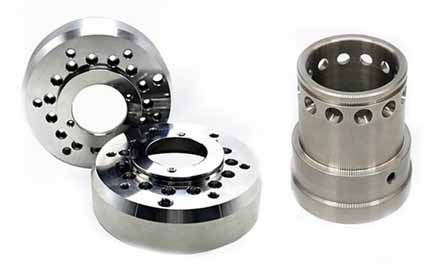Vid höghastighetsfräsning av TC4, Gc.2, och integralstrukturer av rent titan, nedfräsning används vanligtvis. Verktyget skär långsamt in i titan-arbetsstycket för att minska den värme som genereras och minska den radiella kraften.
Vid fräsning av titanlegering TC4 (Ti-6Al-4V), asymmetrisk nedfräsning används ofta, så att främre spetsen på fräst tand först kommer i kontakt med arbetsstycket. When the milling cutter teeth are separated, the chips are very thin and are not easy to stick to the cutting edge. The opposite is true for up milling, which tends to stick chips. När skärtanden skär in igen, chippet är trasigt, vilket gör att skärmaterialet lossnar och flisar. För det andra, maintain a stable cutting load as much as possible, because changes in load will cause tool deflection, thereby reducing machining accuracy and surface quality, and shortening tool life. Till sist, when machining titanium parts with large removal margins (such as groove machining of large titanium parts), layered milling, small depth of cut, and medium feed are generally used. When machining the inner cavity of titanium, when the tool enters the corner, adopt trochoidal milling, which can avoid the sudden increase of cutting force, otherwise the heat generated will destroy the performance of the titanium material.
För närvarande, in the high-speed machining of the aviation manufacturing industry, the milling speed of titanium alloy can reach more than 90m/min, and the cutting speed of aluminum alloy can reach 1500~6000m/min. When processing aluminum alloy in this speed range, the milling temperature is higher than the corresponding temperature at which the built-up edge disappears, which effectively avoids the generation of built-up edge and improves the quality of the processed surface. På samma gång, the higher the silicon content of the aluminum alloy, the lower the milling speed should be. When processing high silicon aluminum alloy, the cutting speed is 300~1500m/min, the processing effect is better.
The commonly used cutting solutions are: high cutting speed, medium feed and small depth of cut. dock, in actual processing, it is not that the higher the cutting speed, the better the effect. It is necessary to comprehensively consider the workpiece, cutting tool and equipment to formulate a reasonable processing plan. Till exempel, there are two boss holes in the cavity of an aircraft wing part (titanlegering) produced by an aerospace manufacturing company. Som visas i figuren 1. Adopting cemented carbide end mills, cutting speed v=1300m/min, feed rate fz=0.5mm/z, cutting depth ap=3~5mm, reciprocating tool passes over the boss hole to process, the processing cost is too high. After process improvement, high-speed steel tools are used in the A area, the cutting speed v=800m/min, the large cutting depth ap=10mm, and the position of the boss hole after rough machining. Replacing cemented carbide tools for high-speed milling in area B not only ensures machining efficiency and surface accuracy, but also reduces costs.

Fräsning av konstruktionsdelar av titanlegering
 English
English العربية
العربية 中文(漢字)
中文(漢字) Čeština
Čeština Dansk
Dansk Nederlands
Nederlands Suomi
Suomi Français
Français Deutsch
Deutsch Italiano
Italiano 日本語
日本語 ಕನ್ನಡ
ಕನ್ನಡ 한국어
한국어 Português
Português Русский
Русский Slovenčina
Slovenčina Español
Español Svenska
Svenska Türkçe
Türkçe

